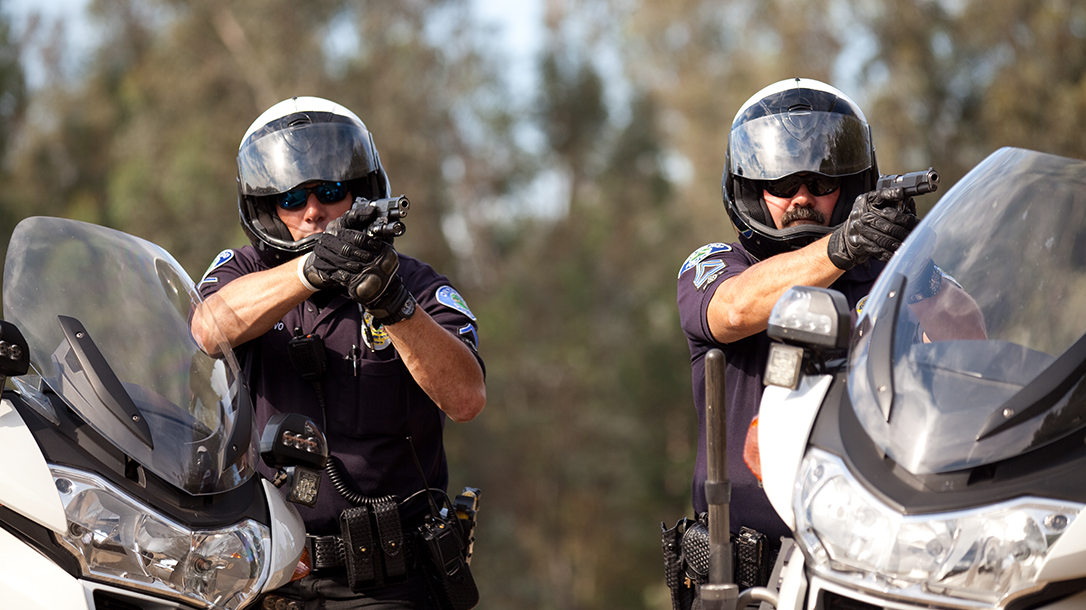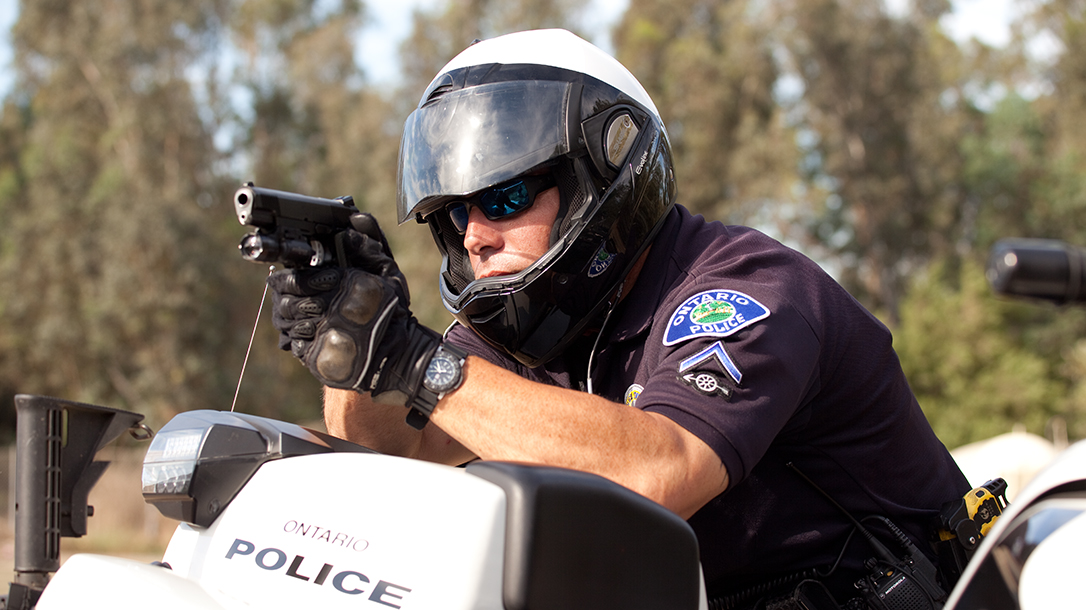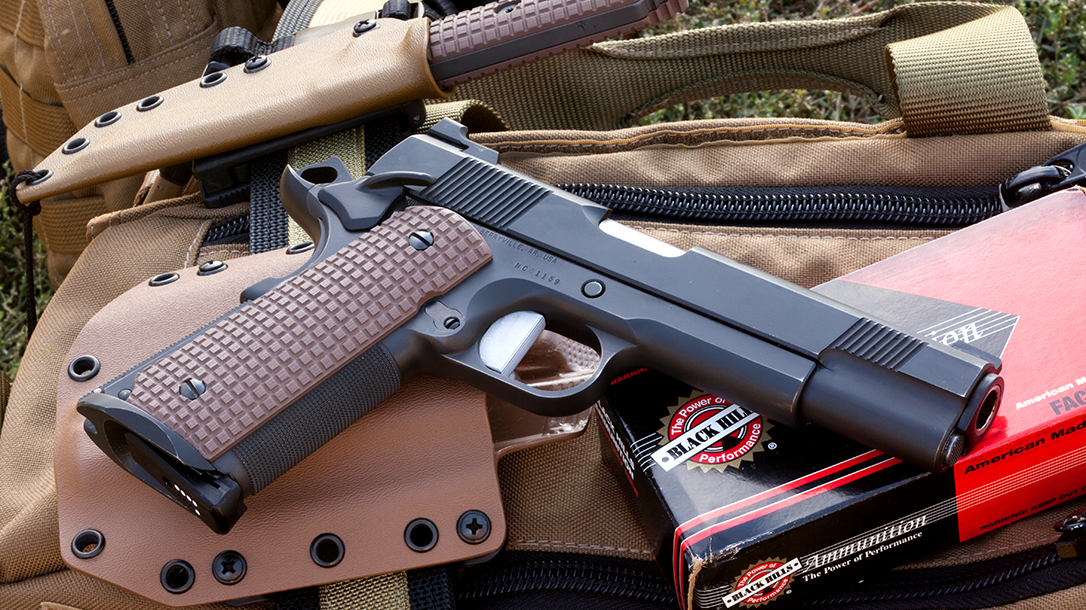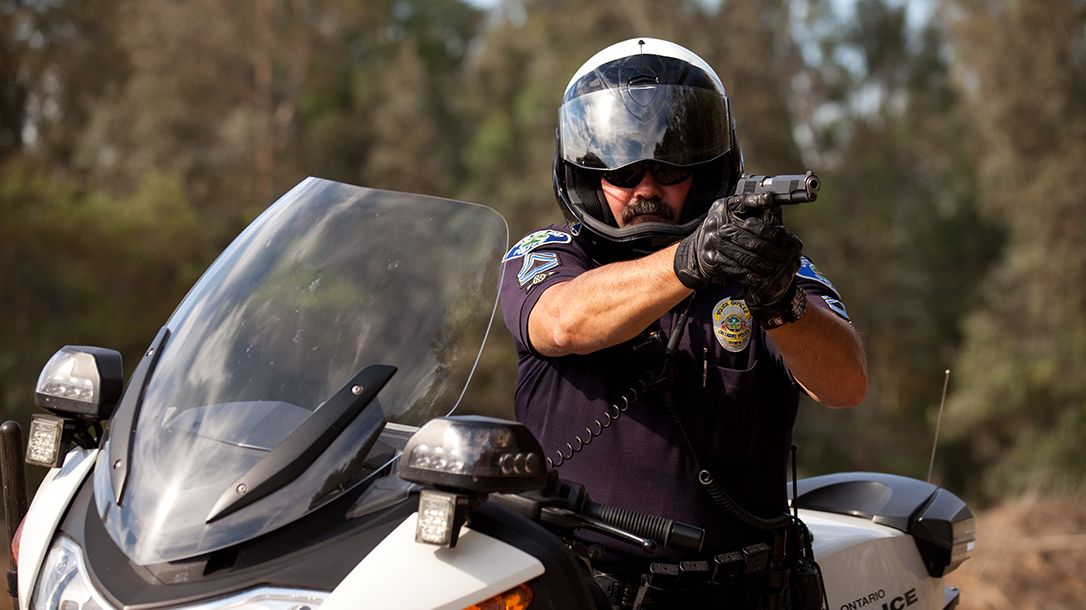This article on the 1911 duty pistol is from the October/November 2016 issue of “Guns and Weapons For Law Enforcement” magazine.
A strange phenomenon has occurred in the last several years in the law enforcement firearms community. The 1911-pattern .45 ACP pistol has made a significant resurgence in acceptance as a patrol or primary duty pistol.
This can be both a good and bad thing, depending on the end-users. The first pistol I ever owned was a Colt Series 70 Government Model. I have never been without a 1911 and never will be. They are probably my favorite handguns ever made, but they are not for everyone. One really needs to put some serious thought into their level of dedication to the system before they decide to make it a primary duty pistol for LE use.
Advertisement — Continue Reading Below
One of the range masters at my old LE agency asked me at one point, “Why do you have the only 1911s that never have problems?” My response: “Because I use Colts, and they all have over $2,000 of work in them.”
As Larry Vickers has so eloquently stated in the past, “The 1911 is no longer a service pistol—it is an enthusiast pistol.” Model 1911s need a different level of dedication for hard service use. When officers start buying guns in the same price range as their current polymer-framed service guns and go 10-8 (in service), they will quickly run into problems. For instance, higher round counts and shooting 1911s hard requires long and expensive relationships with gunsmiths. Even high-end gunsmiths will not help many LE officers with their 1911s, because if the gunsmith is good, they have a long waiting list. Then issues arise with the regular required maintenance. So where does an officer carrying a 1911-style pistol go for help? 10-8 Consulting has come through in spades in this area.
Advertisement — Continue Reading Below
1911 Duty Pistol Experts
As a disclaimer, I have a very long association with the operations at 10-8 Consulting, but I’ve always been at the bottom of the knowledge base when it came to the idiosyncrasies of the 1911. Thankfully, 10-8 Consulting offers a two-day Duty 1911 Course. Because the 1911 pistol requires a more sophisticated end-user to properly operate and maintain the 1911 than modern service pistols, this class is geared towards providing the training needed. This sounded like what I needed, so I signed up for one of the first classes held in Liberty Hill, Texas. To say that I learned a ton is an understatement. The instructional background of the staff provided a unique, real-world level of experience.
Hilton Yam is an active-duty LEO in a large, well-known government agency and is tasked with both supporting and training numerous agents with a large number of issued 1911 pistols. Hilton is also a very accomplished gunsmith in his own right and an exceptional shooter with a long pedigree in this field. He has trained with, and been mentored by, a very large group of the most established names in the 1911 world. He is not the only expert, however.
Other trainers include Tim Lau, Erick Gelhaus, Joe Riedy and Dean Caputo. They are all experts in the use of 1911s as a duty pistol. They also all serve or have served with law enforcement agencies. With this kind of instructional background, you have teachers who have a huge amount of real experience in keeping hundreds of 1911s running in a hard-use duty environment with a wide variety of end-users, rather than keeping a single gun running.
Advertisement — Continue Reading Below
Dispelling Myths
Right out of the gate, the 10-8 crew makes it clear that every part in the 1911 pistol is fitted. It was a gun that heralded from a time when precision machinery was expensive and skilled labor was cheap. The same is not true today. They addressed the time-honored argument of “the military used it without any issues” as well.
The 10-8 team also shared a rare piece of information with the class: The U.S. military’s ordnance department had several “go/no go” gauges for evaluating every single part in a 1911 pistol. This allowed all the parts to be “fitted” prior to entering the logistics system for the military from the vendors. These were guns designed for use with a seven-round magazine and FMJ ball ammunition.
The second you get away from the initial design parameters, there are cause and effect issues. Today, you have numerous makers using different standards, different safety systems, multiple magazine variances and many of the various parts are made with differing goals and end-users in mind—competition, defense, recreational, and target shooting, to name a few. Combine this with the large variance in ammunition that is typically used by law enforcement agencies and you can have a lot of issues. These factors were all discussed in depth, and they should be considered when selecting and maintaining a 1911 for duty use.
Advertisement — Continue Reading Below
We learned to fully disassemble our pistols and evaluate critical parts. In all the years of shooting and carrying 1911 pistols, I have never disassembled a gun to the bare frame. We also learned various ways to fieldstrip the gun. The instructors then went on to discuss common modifications and their pros and cons. Next came discussions about maintenance, upkeep and parts replacement schedules. We spent the first day entirely in the classroom, and the students found the lessons to be extremely valuable.
Even though most of the students were experienced with the 1911 pistol, it was painfully obvious that we were all learning a lot of new things. During the course, Hilton Yam worked on many students’ guns, as issues appeared over two days. There were 16 students with working, quality guns when we started. During the class, Hilton fixed five plunger tubes, nine extractors, two with hammer issues, two loose sights, and two loose grip screw bushings. The complexities of keeping the 1911 running for duty status became crystal clear.
Advertisement — Continue Reading Below
Performance
Day Two started on the range. We shot a special 56-round course specifically designed to identify gun and magazine issues. Several folks left the line and spent some time with Hilton correcting the problems. We spent the rest of the day conducting various drills to maximize our performance with the 1911 pistols.
I used my current carry 1911 “beater.” It is a custom-built 1911 from Mars Armament using a Nighthawk GRP frame, Caspian slide, Kart match barrel, a slew of 10-8 Performance parts and “Frag” grips from Monkey Edge. This gun was seen by Larry Vickers in the past, and Hilton did a little extractor work and an evaluation. I had zero malfunctions. When I did my job, small groups appeared on the targets. It took some time to “un-Glock” my trigger finger, but after this class, I fell in love with the 1911 platform again and came away with a new level of confidence.
I used a full Kydex rig from Raven Concealment Systems on both CSM and Ares Gear duty belts. All of my gear functioned well and reinforced why I use top-of-the-line gear. Ammunition and magazines will often cause major problems with the 1911. All eight of my Chip McCormick black PowerMag magazines with 10-8 basepads functioned without an issue. Black Hills ammo was highly recommended by the 10-8 staff, and it ran very well in my pistol.
Advertisement — Continue Reading Below
I came away from this class with far more than two days’ worth of knowledge. 10-8 packs a ton of information into a short period. It is training that any serious, professional 1911 user should take. If you are responsible in any capacity for instructing or maintaining 1911-style pistols for a law enforcement agency, this class should be on the top of your list as a critical need. I also highly recommend this class for those considering adopting the 1911 to really prepare properly for what it takes to run a successful program right from the start. This course is available in various locations throughout the U.S.
For more information, visit 10-8consulting.com


























